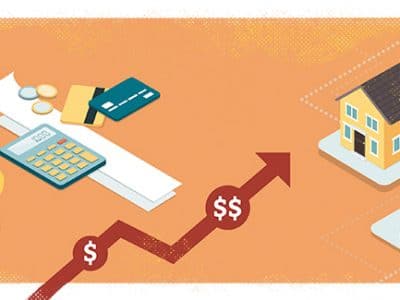
If you get depressed easily, you may wish to skip this article. Our country has suffered inflationary bouts to various degrees throughout our history, with perhaps the most severe having occurred during the Revolutionary War, the Civil War, and the 1970s. Sadly, we have never found a quick, clean way to escape inflation. As those of us above a certain age learned in the early 1980s, the end of a period of inflation can be protracted, problematical, and painful.
A big part of the inflation problem is as much psychological as economic. People start thinking, “I had better buy what I want now, because if I wait, it will cost more and it might not even be available.” This shifts demand from the future to the present and contributes to the basic inflationary problem of more money chasing the same or fewer goods. The Wall Street Journal posted a story on Feb. 7 titled “Two Years Into Pandemic, Shoppers Still Hoarding.”
 Inflation is a huge liability for the political party in power. President Biden has tried to assure Americans that his administration will successfully tackle inflation, but actually there is very little that they can do. In fact, what we have seen so far from Team Biden are examples of things NOT to do.
Inflation is a huge liability for the political party in power. President Biden has tried to assure Americans that his administration will successfully tackle inflation, but actually there is very little that they can do. In fact, what we have seen so far from Team Biden are examples of things NOT to do.
By far, the most important DON’T at his juncture is: Don’t keep increasing federal spending, especially at a time of record deficits. That would pour more fuel on the inflationary fire. Yet, increasing federal spending has been President Biden’s policy priority for much of the last year as he tenaciously sought passage of his trillion-dollar-plus Build Back Better plan. Thank goodness, two Democratic senators, Kyrsten Sinema of Arizona and Joe Manchin of West Virginia, realized the inflationary damage that the federal spending splurge has been causing. They refused to supply the necessary votes to pass BBB despite being cruelly badgered and persecuted by fellow Democrats. Instead, they placed the country’s welfare above partisan victory, and for that we all owe them our thanks.
President Biden has cited some very real problems with supply chains, but then has adopted and advocated policies that will further crimp supply. These policies include: imposing costly regulations on businesses (an additional $200 billion of costs in just his first year as president), hinting at price controls, continuing (in spite of gasoline prices having risen 40% over the last year) to impede production of fossil fuels, proposing to contain rising drug costs by imposing “steep” taxes on pharmaceutical companies, etc.
One particularly silly policy proposal to fight inflation was President Biden’s announcement on Jan. 3 of a plan to lower meat prices by channeling $1 billion in subsidies to smaller meat processors and ranchers. The stated goal was to help them compete more effectively with larger competitors. The actual impact will be to put upward pressure on prices as subsidies always do.
By the way, the current high inflation provides a useful opportunity to take a closer look at Modern Monetary Theory, which is all the rage among progressives. MMT’s prescription for an outburst of inflation such as we have today is to raise taxes on the private sector so as to reduce private demand, thereby reducing the amount of competition government faces when bidding for economic goods. Yes, for the advocates of MMT, what government wants is more important than what private citizens want. That of course, is the everyday reality of socialism.
In fact, the afore-mentioned Senator Joe Manchin—one of the heroes who saved us from Build Back Better—urged fellow Democrats on Feb. 10 to gut the Trump-era tax cuts to combat inflation. Now think about this for a minute: The average American worker, according to the Bureau of Labor Statistics, has seen real wages fall 1.7% over the past year and the middle class is getting priced out of many housing markets. Do you agree with Senator Manchin that increasing taxes should be central to the Biden administration’s plan to combat inflation and rein in the deficit? Manchin and friends will claim that they will only raise taxes on the rich, but there aren’t enough rich people to drive the prices of housing, food, fuel, used cars, etc. higher. It takes tens of millions of people to do that, and so Manchin is endorsing the MMT theory that the way to curb rising prices is to raise taxes on the middle class. Do you want to pay higher income taxes this year with prices soaring? I don’t think so.
 As a young economist, I thought the proper response to inflation might be a deflationary policy whereby the central bank contracted the supply of money. My wise mentor, Grove City College legend Hans F. Sennholz, said something to this effect: “Inflation is like being shot through the front. Would you try to fix those injuries by shooting the person through the back (deflation)?” Both policies are harmful. Sometimes the best thing you can do is simply let the economy make the necessary adjustments and heal over time.
As a young economist, I thought the proper response to inflation might be a deflationary policy whereby the central bank contracted the supply of money. My wise mentor, Grove City College legend Hans F. Sennholz, said something to this effect: “Inflation is like being shot through the front. Would you try to fix those injuries by shooting the person through the back (deflation)?” Both policies are harmful. Sometimes the best thing you can do is simply let the economy make the necessary adjustments and heal over time.
I will close on a sobering note. We are a long way from the Fed’s decade-long policy of aiming for 2% inflation per year. But even under that policy (with the actual rate averaging 1.63%) since the year 2000, the dollar has lost about 39 cents of its purchasing power. The reality is that as long as we allow our government to continue engaging in deficit spending and piling up more debt, we are sentencing ourselves to future inflation. Rather than default outright, we will service our debts with ever-depreciating dollars. It will fall to future generations of Americans to abandon the treachery of fiat currencies, the destructiveness of a politicized central bank equipped with fiat currencies, and the immorality of deficit spending.
Postscript: This was written before Russia invaded Ukraine. I wrote last week about some of the economic repercussions of the invasion. The resulting shortages are likely to cripple production (recessionary) while driving prices of key goods higher (inflationary) all of which portends a return to the stagflationary economic conditions of the late 1970s and early 1980s.




